Contact:
Winter Bug
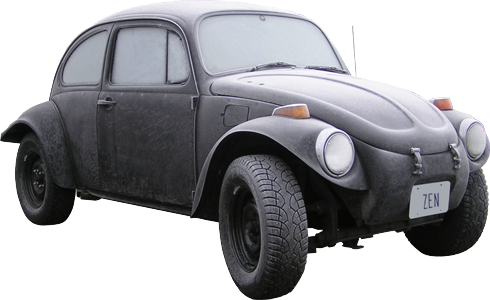
Winter driving with a classic Volkswagen isn't for everyone, but these vehicles were made for winter driving. The rear wheel drive, rear engine configuration and light weight of VWs allow them to outperform many of the newer vehicles of today.
Traction
The rear wheel and rear engine configuration of the early VWs is great for accelerating and climbing hills. The reason for this is that when a vehicle accelerates and/or when it moves up hill (nose first), weight is transferred to the rear of the vehicle. This increases traction to the rear wheels. This gives rear wheel drive and rear engine vehicles an advantage over front wheel drive and front engine vehicles when accelerating on snow and ice and when negotiating slippery hills. This is why front wheel drive cars may make it up an icy hill in reverse but not in first or second gear. That trick turns a front wheel drive car into rear wheel drive car, with a bit of tricky steering.
Those with expensive four wheel drive vehicles will argue against this, but the short wheel base, light weight and engine position of a VW will allow it to climb many hills that a modern four wheel drive can't. Argue if you like, but it true. Note that I said "many" and not "all" hills. I also didn't say supped up 4x4 with locking differentials, giant studded mud tires, with several bags of sand in the back and a running start.
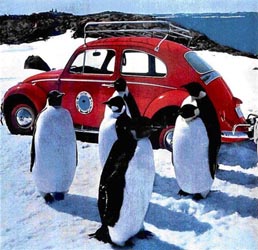
Antarctica 1
The VW Beetle was in fact the first production vehicle to be used in Antarctica, which is about as wintery as you are going to get. There you will find fresh snow, packed snow, ice, glaciers and some very cold weather. And these VWs did quite well, enduring the cold and abuse of flying across the bumpy and frozen wastelands. See Rallybugs for more information.
So 1930's German automotive engineering is great. Yada yada yada. But how do you increase the capabilities of a VW in the winter? First you must understand the basics of winter driving.
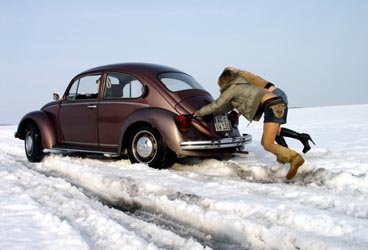
In areas where temperatures drop below freezing, winter driving poses several problems to traction. Snow and ice are the most obvious problems that come to mind, but even the lower temperatures of winter alone can and do decrease traction. As temperatures drop, tires become stiffer. Stiffer tires don't conform as well to the road causing acceleration, braking and cornering abilities to decrease. So, even on bare winter roads, tires just don't perform like they did on hot summer roads. This becomes noticeable as temperatures drop below 45ºF/7ºC.
All-Season Tires with Mud and Snow Designation
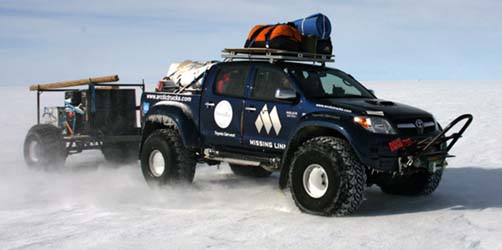
The Mud and Snow designation was originally used to differentiate bias ply "knobby" tires intended for use on muddy and snow covered roads from the straight rib tires used on early cars or trucks of that time period. This was before they came out with and marketed the "all season" radial tires for "year round" use in the 1980s. This outdated tire designation does not signify that a tire is a "winter" or "snow" tire in the modern sense. Mud and Snow tires have an "M+S," "M/S," "MS" or "M&S" designation printed on the their sidewalls.
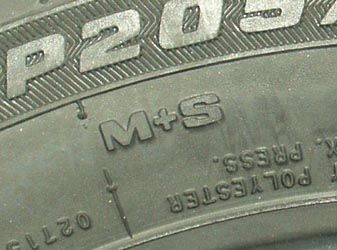
For a tire to receive the Mud and Snow designation, it must meet these geometric requirements set by the Rubber Manufacturers Association (RMA) guidelines for a mud and snow tire:
New tire treads shall have multiple pockets or slots in at least one tread edge that meet the following dimensional requirements based on mold dimensions:
Extend toward the tread center at least 1/2 inch from the footprint edge, measured perpendicularly to the tread centerline.
A minimum cross-sectional width of 1/16 inch.
Edges of pockets or slots at angles between 35 and 90 degrees from the direction of travel.
The new tire tread contact surface void area will be a minimum of 25 percent based on mold dimensions.
This basically means that a Mud and Snow designated tire must have a single row of fairly big grooves that start at the edge of the tread and extend toward the center of the tire and that at least 25% of the surface area must be grooves. This is to give enough void space to bite into snow and mud for traction. There are no testing requirements for actual traction. So in today's world, the Mud and Snow designation is pretty much meaningless as a M+S tire may perform extremely poorly in both mud and snow and still meet the ancient requirements for this designation.
Mud Terrain Tires
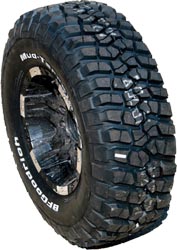
Mud terrain tires are often designed with large lugs to bite into mud, rocks, sand, dirt and snow. Tread compounds vary, but many have high a silica content to stiffing up the lugs. A few tires use softer compound for performance climbing on rocks. In deep snow, aggressive mud tires can perform quite well, until you hit the hard packed snow and ice of unplowed civilization. The compounds, siping (if present at all) and tread designs of Mud tires also don't compare to Winter tires for general cold weather traction.
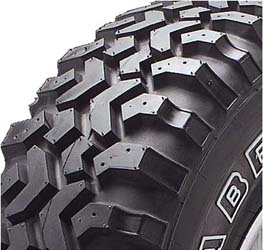
Mud terrain tire can generally be drilled out for studs, and some mud tires come predrilled for studs. This give you the option to run studs for increased ice traction to compliment the soft snow/mud traction from the tire's lugs. Keep in mind that even when siped and studded, mud terrain tires don't come close to providing the same amount of traction on snow and iced covered roads like quality modern winter tires.
Winter Tires
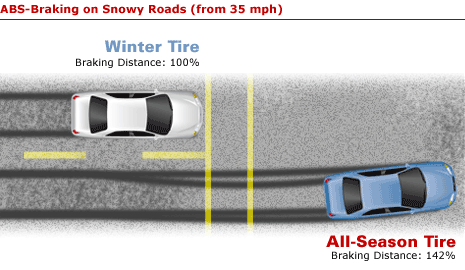
True Winter tires have several features that allow them to drastically outperform Mud and Snow and other non-Winter designated tires in low temperature conditions. Braking, handling, cornering and acceleration are all drastically increased on snow and ice with use of Winter tires over all season tires. So much so that in 2008, Quebec made it mandatory for drivers to have winter tires on their vehicles from November 15 through April 15 of each year. It is generally agreed that Winter tires should be used as temperatures drop below 45ºF/7ºC.
For Winter tires to earn the Severe Snow Use designation, they must meet certain set standards. They are tested using an American Society for Testing and Materials (ASTM) testing procedure described in "RMA Definition for Passenger and Light Truck Tires for use in Severe Snow Conditions":
Tires designed for use in severe snow conditions are recognized by manufacturers to attain a traction index equal to or greater than 110 compared to the ASTM E-1136 Standard Reference Test Tire when using the ASTM F-1805 snow traction test with equivalent percentage loads.
Approved winter tires use several features to achieve this standard. These include generous tire siping, special winter tire tread compounds and special tread designs.
Winter Tire Siping
True Winter tires will have thousands of wavy slits in the tread know as siping. These can provide up to about 40% of the tire's traction on packed and icy snow.
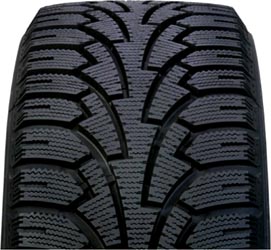
Supposedly, siping was invented and patented in 1923 by John F. Sipe who put slits in his rubber soled shoes to increase traction on slippery slaughter house floors. Later in the 1950s, rubber compounds were developed that could withstand the siping process, allowing for mass production of siped tires. A 1978 study by the US National Safety Council found that siping improved stopping distances by 22%, breakaway traction by 65%, and rolling traction by 28%on glare ice. This is pretty significant.
Why does siping work? The thinking is that all the added edges created by siping grabs onto the road and increases traction on wet and ice roads. These slits are also believed to soak up water from the surface of roads and ice so that the tires don't "float" on a film of water over pavement or ice. Since wet ice is considered the lowest traction surface we can drive on, sipes are one of the more important aspects of a true Winter tire.
Disadvantages:
sipes tend to grab small rocks, glass and other objects that will decrease the service life of tires
ConsumerReports.org recommends against adding more than "the sipes that your tires come with" because of longevity and dry pavement performance
siping have feel squirmy on warm dry roads compared to race slicks
Note that many tire "experts" (often the one providing tire siping service) claim that tire siping increases tire life as it decreases running temperatures of tires. And regardless of whether they increase or decrease tire longevity, they are a must for winter driving.
Winter Tread Compounds
The special tread compounds used in Winter tires provides about 40% of the tire's traction and this remains remarkably consistent in most road conditions, from fresh snow to icy packed snow. These compound benefits only begin to decrease when driving on black ice, where the compounds may only provide about 10% of the traction.
One or more of the following features are used in Winter tires to increase winter traction:
Special winter tire compounds are used to retain tread flexibility in cold temperatures. A tread surface that is more flexible will allow for more traction and control.
Walnut and other "soft stud" tread fibers and treatments allow for increased traction on ice similar to metal studs. These technologies lead to decreased tire longevity.
Silica-based compounds deliver increased wet and snow traction, dramatically improved rolling resistance and enhanced wet handling over carbon based tread compounds. Silica-based compound tires tend to have a 10-15% decrease in lifespan while providing a 3-8% decrease in fuel use through decreased rolling resistance.
Compounds containing thousands of microscopic cells (or pores) and similar technologies create a Swiss cheese like tire surface. These micro-pores create thousands of biting edges and "squeegee" away surface water for increased traction on icy and wet roads. This would obviously have a negative impact on tire tread longevity.
All-season tires have very different compounds than winter tires:
Compounds used are "averaged" to deliver better wear and good traction in a wide range of conditions and temperatures. Use of these compounds provide noticeably decreased traction below 45ºF/7ºC.
Non-winter tires use denser compounds for increased tire longevity.
Tread compounds with higher levels of carbon black and less silica have improved dry handling at higher speeds and greater tire longevity.
Winter Tread Design
The tread design of Winter tires was created for improved handling and braking on snow and ice. Earlier mud and snow designs used aggressive lugs to bite into snowy and mud covered roads. Modern Winter tires are designed for increased traction on snow and ice with maintained traction and comfort on dry roads. It is important to note that in fresh snow, the grooves, block layout and pattern provide about 50% of the tire's traction. As the snow becomes packed or icy, the benefits of the tread design drop off significantly.
Winter tread designs incorporate:
Special lug and groove shapes are designed for greater bite into deep snow and clearing of snow when the tire rotates.
Wider circumferential grooves allow for more efficient channels to drain water and remove snow.
Sophisticated, high-density sipe designs allow for greater penetration into water and slush and provide more "edges" to grab onto the road surface.
Rounder casing designs allow the tire to cut into the snow's surface for a deeper bite with increased traction.
Older "Snow" tire designs often incorporated more aggressive shoulder grooves designed to dig into mud and snow. Newer designs incorporate smaller shoulder grooves that increase snow and ice traction without the sacrifice of dry road handling and ride.
All-season tires are designed for a wider range of temperatures and longevity.
All season tires lack the tremendous siping found on Winter tires.
The shoulder block and groove designs allow for a compromise for cornering, wear and all-season traction.
The flatter tread designs of all season tires don't cut into snow as effectively, but provide greater traction on dry roads.
All season road tire tread designs tend to be less aggressive than winter tires to allow for a more comfortable and less noisy road ride. The treads are more likely to pack up with snow than Winter, Mud and Snow or Mud tires.
Winter Tire Stamp

Mountain/Snowflake Pictograph
The RMA (Rubber Manufacturers Association) designates winter tires that meet the new Severe Snow Use standard with a Mountain/Snowflake Pictograph. Tires that lack this symbol are either not true winter tires or were made prior to the use of the Mountain/Snowflake Pictograph. So if you are driving in temperature below 45ºF/7ºC, you should ideally be running an approved Winter tire. Mud and Snow tires just don't cut it.
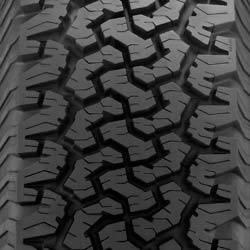

Of note, the venerable BF Goodrich ATs meet the RMA standards for Severe Snow Use. It also meets the guidelines for "Mud and Snow" designation, which is more or less meaningless. These BFG ATs perform well all year round in most terrains and with a little extra siping will perform even better on ice, snow and wet roads.
Four vs Two Winter Tires
In some places, tire retailers are not allowed to sell or install anything less than a full set of 4 Winter tires. This seem like a ploy to squeeze more money out of the consumer, but with the substantial benefits of snow and ice traction from today's true Winter tires, using only 2 Winter tires creates a dangerous and unpredictable traction mismatch leading to understeer in one condition, oversteer in another and spinouts galore.
A Volkswagen with four matched and true Winter tires does very well in the Winter. The Ice Bug at the to of this page performed very well as others were spinning out around it on icy roads..
TIRES FOR WINTER DRIVING - RUBBER ASSOCIATION OF CANADA
Tire Compromise
Even when taking cost out of the equation, tires are always a compromise of many factors. Even with Winter tires, these vary in how well they perform on various conditions. And don't forget that your winter tire may also need to be driven on water covered and bone dry roads.
So what is the "best" winter tire? Besides the compromise issue, newer Winter tires keep outperforming older Winter tires. So the "best" tire for your traction preferences will change each year with the introduction of newer and better tire designs.
Studs
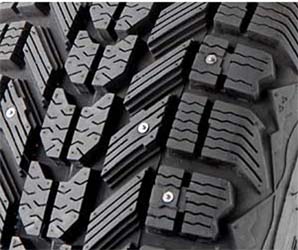
Many Winter and other tires are set up for metal studs. And nothing provides chainless tire traction on ice like metal studs. There are soft stud tires available on the market that perform well, but they still don't perform as well as metal studs on black ice. As temperatures drop and the ice becomes harder, especially below -4ºF/-20ºC, tire studs will become less effective even on ice.
Unfortunately, studs come with significant compromise. They decrease traction and increase braking distance on ice and snowless roads. The are also noisy and cause significant damage to roads where they are legal to use.
Chains
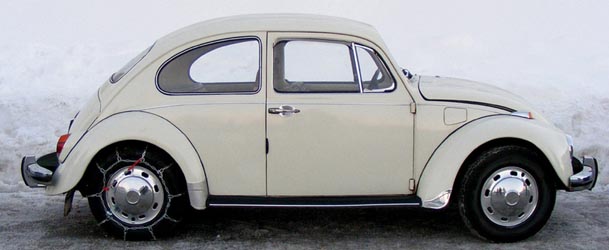
Chains provide awesome traction on snow packed roads, ice and even on muddy roads. They unfortunately perform terribly on bare roads and require you to install and remove as needed.
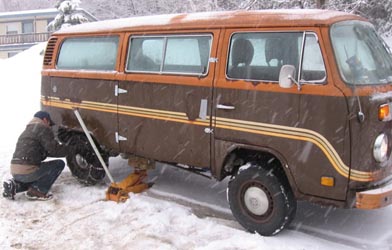
Luckily we now have may "chain" options now a days. Some are "disposable" while others are hi-tech in design and construct.
Siping Tires
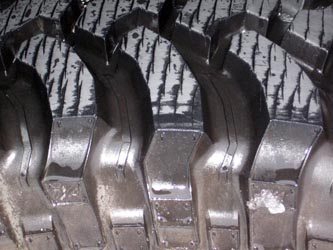
The benefits and disadvantages of tire siping have already been discussed in the Winter tire section above. But if you are not running true Winter tires, you can have your tires siped. Many tire retailers will provide this service for you and given the potential increase in snow, ice and wet pavement traction, it is well worth the minimal investment. DIY tire siping of your street or offroad tires is also possible if you have a lot of free time and want to "do it right."
GENERAL GUIDELINES ON SIPING & GROOVING HOOSIER SPRINT TIRES
Pine Resin

The manufacturers of Tyre-Grip claim a 300% increase in traction for 50 miles with just a quick spray of your tires. Their secret is pine resin soaked in isopropanol and/or Toluene as well as TV marketing.
Does it work? The Tyre-Grip site says that it does. And if it does, it might be just the thing for those place who only see snow once every other year. In places such as Seattle, where novice drivers send cars and busses up and down steep steep roads covered in ice, drivers may benefit from an emergency can of sap in the trunk. Then again, perhaps they should just stay at home.
Tire Size
Most feel that a skinny tire will work better than a fat tire
on ice, snow and just about anything other than sand. For snow, the
thinking is that it will cut through snow and decrease rolling
resistance. Less rolling resistance means that snow is less likely
to slow you auto to a stop. There is also a school of thought that
skinny tires will cut into snow and grab better traction down under. There
is some merit to this line of thinking, but it has less validity than it
used to. There may be a little extra traction down deeper in the snow but,
in reality, not much.
The digging down deep theory works best on soft fluffy snow. Contact
pressure is also increased with narrower tires. This helps traction
in some situations while causing tires to dig into deeper ruts in others.
Modern winter tires are designed to actually use the snow for traction.
These tires compact snow in the tread grooves and it then binds to the
snow on the ground as the car’s weight creates water. The process is sort
of like making a snowball. The tire uses this bond to push itself off the
snow on the ground to create forward motion.
Some feel that downsizing your tire to a narrower one will decrease braking performance on dry roads.
A 215/70R15 Winter tire will fit nicely on 5.5inch stockies with little or no rub on a stock height Baja Bug. And despite everyone saying that smaller tires will work better in the snow, these look cool. And cool sells more tires and cars than performance.
Defrost
You need to be able to see out of your windshield to drive safely. This means that you need to keep the windshield from fogging up and icying over on the inside and outside of your windshield. This can be a pain.
The stock heating system is probably sufficient for defrosting your windshield when everything is in working condition. That means that it may be time to rebuild and replace you heater/defroster components.
Electric Defroster
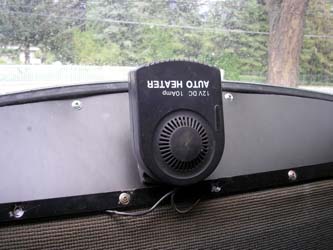
A purpose made defroster or 12v hairdryer may do the trick to clear away some of that icy glass.
RoadPro RPSC-818 12V Hair Dryer/ Defroster with Folding Handle
The Force

If you find yourself in that situation where once you get to the highway, your windshield freezes over, you can Use the Force.

Simple hold your right hand out directly in front of you and press it against the windshield. Once you see fog forming around your hand, quickly remove it and wipe it dry with the dry washcloth you store on the passenger seat. Next hold your left hand out next to the cleared away spot. Repeat as necessary. You may also need to hold your hands together and breathe on them from time to time to rejuvenate the Force in your hands.
If you are sitting in your VW and waiting for the engine to warm up, you can prophylactically preheat your windshield with your hands if to see it is starting to fog up or expect it to ice over shortly after you hit the road.
Preheating your VW
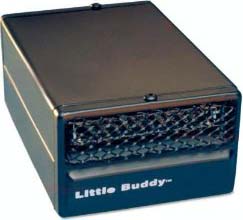
Placing an electric garage/household/boat heater in your VW and plugging it into an extension cord plugged into a timer will heat your VW up nicely before you get in in the morning to start her up. Done right, it will premelt the ice on your windshield and raise the temperature of your glass and seats above freezing.
Zerostart 260-0900 Little Buddy Interior Warmer
Window Down Driving
If you are bundled up in your VW, you can drive with the windows cracked or even all the way down. It doesn't seem to increase noise all that much in many VWs and does increase driver side visibility.
Spray/Rub On Deicers and Defoggers
Methyl alcohol, propylene glycol and other agents are used in commercial window deicers and defoggers. And although propylene glycol is considered non-toxic and methyl alcohol isn't that toxic (unless you drink it), spraying it in your VW while driving doesn't sound very appealing.
Mini Ice Scraper
I have a nice ice scraper with a heavy duty squeegee on it. It has lasted for many years and I haven't found a good replacement of it yet. That said, there are other scrapers that are suitable for the inside your VW, and some are even heated. Some can even be used to scrape the outside window to some extent with you inside. This is nice for that early morning outside fogging that freezes over when the conditions are just right. Of note, this does looks silly and other drivers will tend to stay away from you after demonstrating this trick.
Salt and Sand Splatter
When road and weather conditions are just right, you may find yourself in a cloud of salty dirty mist thrown up by the SUVs and trucks around you. Your wipers should be able to clear away the water on your windshield, but if it things dry just right, you will be left with a film of dried salt and sand streaked across the forward field of view. You can usually see through it, but it is annoying in hours of darkness. The "Force" also doesn't work against salt. It just stays there on your windshield until it washed off or after it begins to snow or rain. A reminder that an acidic mix of electrolytes helping to eat away at every crack and scratch on your beloved VW.
To combat windshield film, you need water, ideally mixed with windshield washer antifreeze/deicer. If your stock windshield washing system is inoperable or missing, you can easily install a system from a Mexibeetle, parts from a random vehicle at the junk yard, or a generic kit found at the auto parts store. You can also use a bicycle squirt bottle for an occasional spray form the driver side window.
If your VW is in really good condition and the washer system doesn't work, it may be because you don't know how to use it. Depending on your year and make, your reservoir may be be a standalone system or hooked up to your spare. If it is a standalone system, you will need to pressurize the tank at the gas station or with a bicycle pump to 35lbs/in2(2.5kg/cm2).
1965 Bug Windshield Washer Questions
Heat
Older Volkswagens do come with a working heater from the factory, and it did work well. Since the new last aircooled VW was sold to the industrialized world some time ago, there is a good chance that something, or possibly everything, in your heating system is not ready for the winter. So it may be time to replace heater manifolds, tubing, heater channels, cables, etc.
The one big issue in getting heat into a VW is to keep the cold air out! A warm winter VW needs to be air tight. This means that you need to inspect the dash and seal off every little hole and crack, to include sealing off the ashtray.
Booster Systems
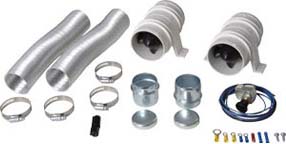
Booster fans will increase the amount of heat in your VW, especially if you choose to cut out holes in your firewall so that you can recalculate air from the inside of your VW back through the heater manifolds. You will need an good alternator and battery to run a good set of booster fans.
Electric Heat
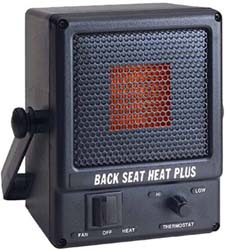
Many VWers with engineering degrees are all out against electric heat. And if you do the math on generator/alternator output and heater requirements, you will see that electric heat doesn't work. But if you don't have an engineering degree and have tried a electric heater, you may have found that with proper wiring, these heaters can really take the chill out of those long commutes. Just make sure they are off when the engine isn't running or you may be practicing your push starting skills on ice.
Back Seat Heat Plus 1100 BTU 12 Volt Truck Heater
RoadPro RPSL-681 12V Direct Hook-Up Ceramic Heater/Fan with Swivel Base
Propane Heater
Propane is easy to find in many parts of the world and minipropane heaters will do a nice job of warming up a Bug or Bus in no time. Unfortunately, unvented propane heaters are not ideal in enclosed spaces as one of the byproducts of burning propane is water, which can create a considerable amount of condensation on the inside of your VW. There is also the concern that the flame can go out while driving, which can lead to a cabin filled with explosive gas. Low oxygen and carbon monoxide of course can kill, but it seems harder to do with a propane heater than you might think. Then there is the fire risk of leaving the heater burning on the passenger seat.
Gas Heaters

These kick butt! They do require some special plumbing and hardware.
Jackets and Gloves

These work good too. Just remember that it may be hard to adjust your radio with certain gloves. Gloves also prevent you from Using the Force. And although cute, this heating method doesn't always go over so well with wives, girlfriends, or potentials of either.
Carpets and Insulation
This seems like a good idea, especially for Busses. In the winter time, where there is lots of snow, you may bring in a lot of that snow with you. As it melts, it like to travel under the carpet where it hangs out. This may lead to rust and more holes in your floorboards. Some prefer to leave the leave out the carpet altogether to allow your VW a fighting chance against melted snow and mud.
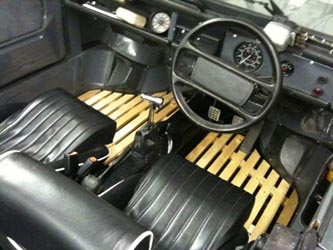
http://www.vw182.co.uk/index.php/2010/04/19/duckboards/
http://www.thesamba.com/vw/forum/viewtopic.php?p=4374528
http://forums.tripwireinteractive.com/showthread.php?t=26726&page=4
http://www.dastank.com/1969-VW-Thing-Feuerwehr-Fire-Brigade-Type-181
Winter Engine Oil
The engine oil argument is always fun. If you are running your VW in the winter, it will love you if you opt to use synthetic multi-viscosity oil in the engine. For the transmission, you should run synthetic oil year round.
Winter Starting and Running
Starting and keeping a VW running in the cold requires may require a little understanding of who a VW works, especially if something is missing, broken or has been modified by the previous owner.
Cold Oil
Engine and transmission oils become thick and slow when they get cold. This makes it harder to turn over the engine and transmission and decreases lubrication. You should use a multi-viscosity synthetic oil in your engine and synthetic oil in your transmission.
A VW block heater will help things along. If you don't have one, a heater point at or light bulb under the engine will help out a lot. These can be plugged into a timer that turns on before you get in your car.
Starting
Tap three times on the gas. Press in the clutch. Start. Taping on the gas will prime the intakes with cold gas and holing in the clutch will make it easier to turn over you engine. When you let up on the clutch, you will find that your engine will move your VW, even when in neutral. Yep, the transmission oil is that thick.
Cold Air
Like most fuels, gasoline needs to vaporize to burn. It also needs to vaporize to get to the intake valves in a timely manner. The challenge with a VW flat 4 is that the gas has to move a long ways to get to the cylinders. So far that without a good manifold heating system, your fuel will fail to vaporize and will dribble down the iced over manifolds causing the engine to die and/or run terribly. This can be bad enough to convince you to give up VWing altogether. Now the stock VW system worked great. But if the riser tubes are plugged or if the carburetion or exhaust system was replaced with a poorly engineered Chinese knockoff, you will have some work ahead.
The answer is to replace that single central carburetion with a dual carburetion system or figure out a good way to heat up those manifolds. The manifolds can be heated with heat from the exhaust in a number of ways and you can find more information on our Zen Weber Progressive Page.
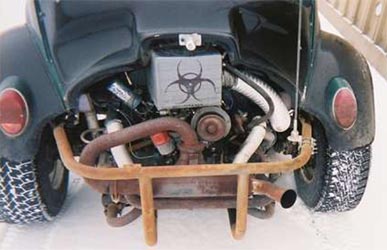
http://www.instructables.com/id/Homemade-Intake-Defroster-for-a-Baja-Bug/
Cold Battery
The electricity from a battery is created by chemical reactions within. The colder the temperatures, the slower the chemicals react and the less current is produces. Add the resistance from your cold engine and the thick oil in your engine and transmission, and you are asking a lot from that battery. Luckily it doesn't take much to turn over a VW engine, but if your battery is not up to it, it's time to replace it. Battery warmers are also available and can be wired to your block heater and cab heater, but if your battery is having trouble, it's really time to replace it. Optimas are cool.
Thermostat
Your aircooled VW came with a well engineered cooling system with a thermostat. The thermostat decreases engine warmup time and helps prevent overcooling in the winter. Preventing overcooling will also increase your engine life. It might be time to find a stock air shroud and working thermostat.
Water/Ice in Fuel
Condensation occurs on the inside of fuel tanks and that water settles in the fuel. Fuel and water don't mix well and water alone can cause problems in your carb. Water can also freeze and block your fuel line. This can become a significant problem. The solution is to keep the water out of your tank in the first place by keeping the tank full. You can also use a fuel additive to "dry" out your fuel. Methanol in the form of "HEET" works well and Seafoam seems to work well at cleaning out your fuel system and combustion chambers. It wouldn't hurt to use Seafoam once a year.
Starting Fluid
Your combustion chamber needs the right mix of compressed oxygen and vaporized gasoline to run. If your mix is off, you might not be able to start your engine. When it is very cold, you may end up flooding the engine with wet gas. Ethyl ether as a wide combustion range can can make it easier to start that reluctant cold engine of yours. It is also great for seating tire beads on a wheel when out in the woods.
Winter Parking
Winter parking can be hazardous to your health as well as the health of your VW.
Parking Brake
Do not use your parking brake when you park. You may have water on your cables, which will freeze and lock your brakes.
Wiper Blades
Place them in the up position so that they don't freeze to your windshield. If you are into gizmos, you can try your luck with heated wiper blades.
HEATED WINDSHIELD WIPER BLADES
New Heated Wiper Blades From Rostra Precision Controls
Hills
You park where you can park, but given the choice, don't park on the side of a hill. Icy hills are places where other motorists tend to lose control and you may be more likely to get hit on the side of or bottom of a hill. If you get hit on the side of a hill and if the hill is icy enough, this impact can cause your VW to slide down the hill out of control. If it isn't icy enough, the impact may be enough to knock your transmission out of gear and cause your VW to roll down the hill. If you intentionally park on a hill for a gravity start, it's time to fix your VW.
Driving on Ice and Snow
There is so much that goes into driving on ice and snow. Even a well maintained VW with modern winter tires can find itself in challenging situations in cold weather conditions. Drive safely and good luck.
Basics
Drive slower on snow and ice than you normally do on the same dry roads. Ice and snow are slippery.
Try to brake, turn and accelerate separately. Each change individually can cause you to lose traction. Combined braking and turning, accelerating and turning or braking, accelerating and turning multiplies the possibility of you loosing traction.
Brake and accelerate easily. Hard or even moderate changes in speed can cause you to lose traction. Suddenly letting off the gas causes rear wheel compression braking which likewise can cause lose of traction.
If possible, slow down before you get to a turn and ride through the turn without braking.
Drive defensively. Increase your distance between vehicles and avoid the temptation to pass and cut off roadway morons until excessively safe to do so. Also consider hitting the roadways when it isn't so crowded.
Learn how to pump your brakes. Pumping brakes in a VW will bring it to a stop faster than locking up the brakes and hoping for the best.
Keep your fuel tank full so that you won't run out of fuel while stuck in traffic.
Consider reading up on winter driving and attending a good winter driving course.
Consider purchasing an SUV, not because it has four wheel drive, but because your chances of survival are greater inside one of these than inside a VW when hit by another SUV.
AUDI TV - How to drive safely in winter conditions
Winter Driving Tips on Braking
Winter Driving Tips on Accelerating
Please feel free to link to this site so that others can find it. It's easy to link to this site, just copy one of the texts below onto your web page:
Copyright © 2000-2010